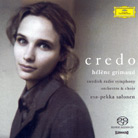July 2004
Grimaud is not your usual artist. Born in France, now living in New York, she has a capacity known as synaesthesia, she hears in colors. Most musicians that have possessed this faculty have been composers. Scriabin comes to mind. In an interview in the booklet for this SACD, Grimaud describes the "Tempest" Sonata as black and blue and the Corigliano piece as "mostly red." To further establish her eccentric nature, Grimaud is also a fancier of wolves. She runs a center near New York where wolves can live and groups of children can visit to learn about wolves and their environment. When listened to in sound, and not scoffed at on paper, Grimaud’s program makes sense. The Corigliano work, based on a theme from Beethoven’s Seventh Symphony, leads naturally to the latter composer’s "Tempest" Sonata. This, in turn, segues successfully to the same composer’s "Choral Fantasy," which begins with solo piano and ends in a blaze of glory for soloist, chorus, and orchestra. The Pärt work begins with chorus and orchestra and the piano comes back from a rest to play a Bach Prelude. Try juggling the works in a different order and they do not work. Grimaud is not all intellect, full of off-beat theories. Her playing is technically assured and mixes equal amounts of heart and mind. She can bring a wistful tear to the eye with the lyric beauty of the last movement of the sonata, or make blood run hot with the stormier moments of the "Choral Fantasy." She is fully supported by Salonen, one of our greatest overlooked conductors. Listen to the sound of the French horns' first entrance in the fantasy and prepare to get goose bumps. In fact, this recording is the best I have heard of the Beethoven fantasy, making it seem a much more significant work than usually thought, and Grimaud and Salonen work as a real team in presenting it. The Swedish Orchestra and chorus prove up to any challenge, and is solid in all four orchestral divisions. The solo pieces were recorded in a studio situation and the works for piano, chorus, and orchestra were taken from live-performance recordings. It is remarkable that the engineers could match the sound of the solo piano in two different venues. When the fantasy starts after the sonata, it is as if the chorus and orchestra had been transported to the studio, not vice versa. The piano sound is very natural and focused, no doubt due to the use of the center channel throughout this whole disc. The orchestra sounds very full and warm, with singularly well-focused bass and sweet highs. The surrounds give roundness to quieter moments and a sense of auditorium as the echoes of louder passages bounce off the side and rear walls. This is such an auspicious debut recording that I cannot wait to hear what Grimaud has coming next. GO BACK TO: |
 Credo - John
Corigliano: Fantasia on an Ostinato; Beethoven: Piano Sonata No. 17 in D
Minor "The Tempest," Fantasia for Piano, Chorus, and Orchestra "Choral
Fantasy"; Arvo Pärt: "Credo" for Piano, mixed choir and orchestra
Credo - John
Corigliano: Fantasia on an Ostinato; Beethoven: Piano Sonata No. 17 in D
Minor "The Tempest," Fantasia for Piano, Chorus, and Orchestra "Choral
Fantasy"; Arvo Pärt: "Credo" for Piano, mixed choir and orchestra Most new artists
making a debut recording will stick to something tried and true, perhaps a Rachmaninoff
concerto or three Beethoven sonatas, perhaps the Chopin second sonata and some shorter
pieces by the same composer. Hélène Grimaud would have none of this, choosing a program
that seems bizarre on the surface, yet proves to be inspired.
Most new artists
making a debut recording will stick to something tried and true, perhaps a Rachmaninoff
concerto or three Beethoven sonatas, perhaps the Chopin second sonata and some shorter
pieces by the same composer. Hélène Grimaud would have none of this, choosing a program
that seems bizarre on the surface, yet proves to be inspired.